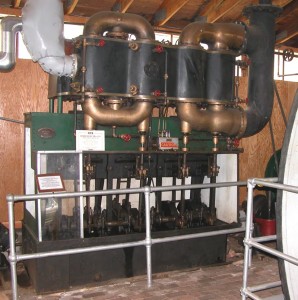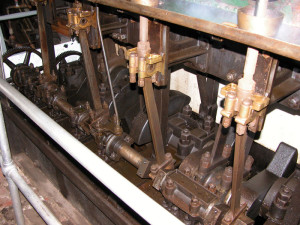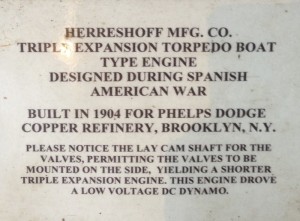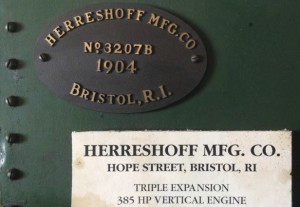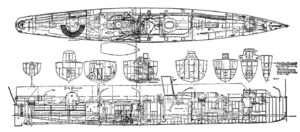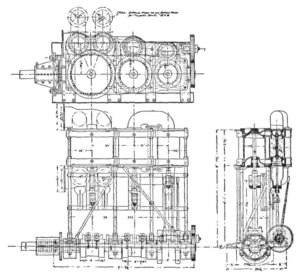This triple expansion engine was built by the Herreshoff Manufacturing Company in Bristol, RI in 1904 as internal job number 3207B. It has three cylinders with bores of 12 1/2″, 18″, 25 and a 13 1/2″ stroke. It produces 385 HP at 300 RPM on superheated steam. It exhibits many ingenious techniques to reduce weight and size, for example, the split connecting rods and the side mounted valves. In a triple expansion engine, thermal loss is reduced by expanding the steam in three stages from boiler pressure to condenser pressure. The total temperature drop is divided into three parts so that the temperature difference across any cylinder is one third that of a single cylinder engine. Heat loss is correspondingly reduced.
This steam engine was designed in 1898 to power the torpedo boats Morris, Gwin and Talbot that Herreshoff built for the US NAVY. Our engine was built without the normal marine reversing valve gear and was used to power low voltage DC generators at the Nichols Copper Company Laurel Hill copper refinery in Maspeth, Queens, Long Island, NY. This plant used the electrolytic process for refining of “blister” copper from it’s smelters in Arizona into 99.99% pure electrical grade copper. About 90% of the “blister” copper was supplied by the Phelps Dodge Company. Phelps Dodge Company bought the company in 1930 and it became the Phelps Dodge Refining Company. At this point in time they were refining scrap copper from the eastern US, and “blister” copper from Arizona and South America. This steam engine ran from 1903 when it was installed until 1982, shortly before the plant was closed.
In 1875 Dr. John Brown Francis Herreshoff (1850-1932), brother of the famous yacht designer Capt. Nathanael Greene Herreshoff (1848-1938), was hired as the superintendent of the Laurel Hill Chemical Works of W. H. Nichols and Company. He invented a water-jacketed copper smelting furnace (Patent US273840A), and in 1890 became vice president of the Nichols Chemical Company, the parent company of the Laurel Hill Chemical Works. The Laurel Hill Chemical Works produced so much copper in comparison to chemicals that it was renamed the Nichols Copper Company. In 1899 Nichols Chemical Company and 11 other companies joined to form the General Chemical Company. In 1900 he became vice president of the Nichols Copper Company and a consulting engineer to the General Chemical Company. He also hired his nephew James Brown Herreshoff (1878-1945) who worked at the company until 1915. His grand nephew James Brown Herreshoff (1909-1986) also worked at the Nichols Copper Company in 1913 and 1914. With the large influence of the Herreshoffs at Nichols Copper Company it is easy to see why they bought several Herreshoff steam engines.
The engine was donated to the NEWSM in 1982 by the Phelps Dodge Company. The engine was rigged and delivered from Queens to the museum by Dave Smith and Paul Merriam.

